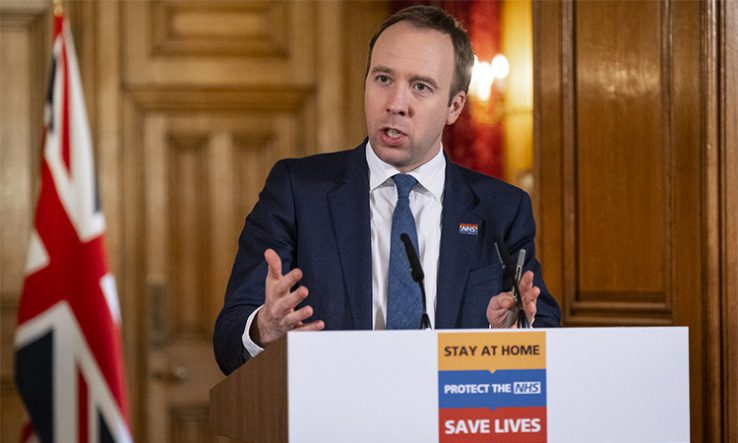Commentary by John Lister –
After a week of belatedly showing some apparent concern at the high levels of deaths in care homes from Covid-19, Matt Hancock and other ministers appear to have reverted to smug indifference with the announcement as The Lowdown goes to press that numbers of deaths have begun to fall back.
He told the BBC’s Radio 4 Today Programme on May 12 that “I’m really pleased that the number of people dying in care homes is now falling, quite sharply. The number has almost halved over the past two to three weeks, since the peak. It’s very clear to me that the transmission in care homes is coming down and is much lower than it was.”
Figures from the largest charitable care home operator MHA, published on May 11, do show a substantial reduction in deaths from Covid, and ONS figures also show deaths in care homes were down in week 18, to the still much higher than average figure of 6,409. But worryingly 37.8% of those deaths involved coronavirus, up from 35.3% the previous week.
And it seems clear that the reduction in the latest figures comes despite and not because of the government, which has failed to deliver the promised financial or practical support, or the necessary level of testing for the virus.
The Guardian on May 11 reported complaints from Cheshire and Birmingham that care home tests were simply not collected for processing, and an Oxford care home, whose chairman of Trustees said: “As of yesterday we still have not received any swabs to do the home testing of residents which we first requested on 27 April when Matt Hancock said that home testing was available.”
Back on April 2 the government guidance to care home bosses promised:
“We will ensure a longer-term supply of all aspects of personal protective equipment (PPE) for care homes – and home care providers – so that staff can provide care, as well as providing a national supply disruption line for immediate concerns.”
But even now the long-promised Amazon-style “Clipper” system, set up after the failure of NHS Supply Chain to dispatch personal protective equipment to hospitals, GPs and care homes, is not yet running or supplying vital kit for care homes, even though Public Health England data at the end of April showed the virus had established itself in more than 4,500 care homes in England, and by May 8 PHE reported that had risen by another 600 to 5,117, a third of all the 15,517 care homes. The most affected areas were the North East with 44% of care homes, and the North West with 39.5% ahead of London’s 38.5%.
The April 2 government guidance also promised financial support to care homes: “We will work with commissioners to ensure fair and prompt payment for the existing care commitments and additional care provided during the response to the pandemic, recognising that both PPE and staffing costs are higher than usual.”
However six weeks later concerns for the future financial viability of the care home sector, notably the thousands of smaller care home providers, have been reinforced by the continued failure of the NHS or many local councils to provide the promised support.
Even the largest providers are facing problems. On May 7 the Care Provider Alliance, representing the ten largest national care associations in England, again issued a public warning on the “significant number of providers” who are still extremely concerned about their cash flow.
“Our members have made us acutely aware of the increase in costs faced by many providers. This includes increased payroll costs due to sickness, isolation and shielding. Furthermore, where providers can actually access personal protective equipment (PPE) they often face costs far above normal prices.
“Although central government announced £3.2 billion had been made available to strengthen care for vulnerable people back in March, we know it’s not flowing quickly from local authorities to providers.”
At the beginning of May Britain’s largest for-profit care home provider HC-One, weighed down by payments on bail-out loans worth more than £265m, sounded the alarm on the financial impact of the pandemic.
The CPA also warned that many councils were still simply refusing to stump up any extra funding to cover the extra costs: “We have also heard from our members’ instances where health and care commissioners have advised “business as usual” and that they are not intending to provide extra funds as a result of COVID-19.”
Worse still, the Independent has revealed that seven councils – Sunderland, Birmingham, and Coventry city councils, Warwickshire, Staffordshire and Derby county councils and Solihull council – have so far invoked emergency powers in the Coronavirus legislation to abdicate from their duty to provide for vulnerable residents.
The case for sweeping reforms to bring the failing network of privately-run care homes into a publicly owned, funded and delivered National Care Service has been significantly strengthened by the revelations, while the visible reluctance of cash-strapped councils to shoulder any responsibility for the most vulnerable people suggests they are unfit to run such a system in the future.
Dear Reader,
If you like our content please support our campaigning journalism to protect health care for all.
Our goal is to inform people, hold our politicians to account and help to build change through evidence based ideas.
Everyone should have access to comprehensive healthcare, but our NHS needs support. You can help us to continue to counter bad policy, battle neglect of the NHS and correct dangerous mis-infomation.
Supporters of the NHS are crucial in sustaining our health service and with your help we will be able to engage more people in securing its future.
Please donate to help support our campaigning NHS research and journalism.


